Above Ground Root Cellars – Enjoy Your Local Produce Longer
When you can’t dig a traditional root cellar, there are still above ground root cellar type options that will allow you store fruits and vegetables longer.
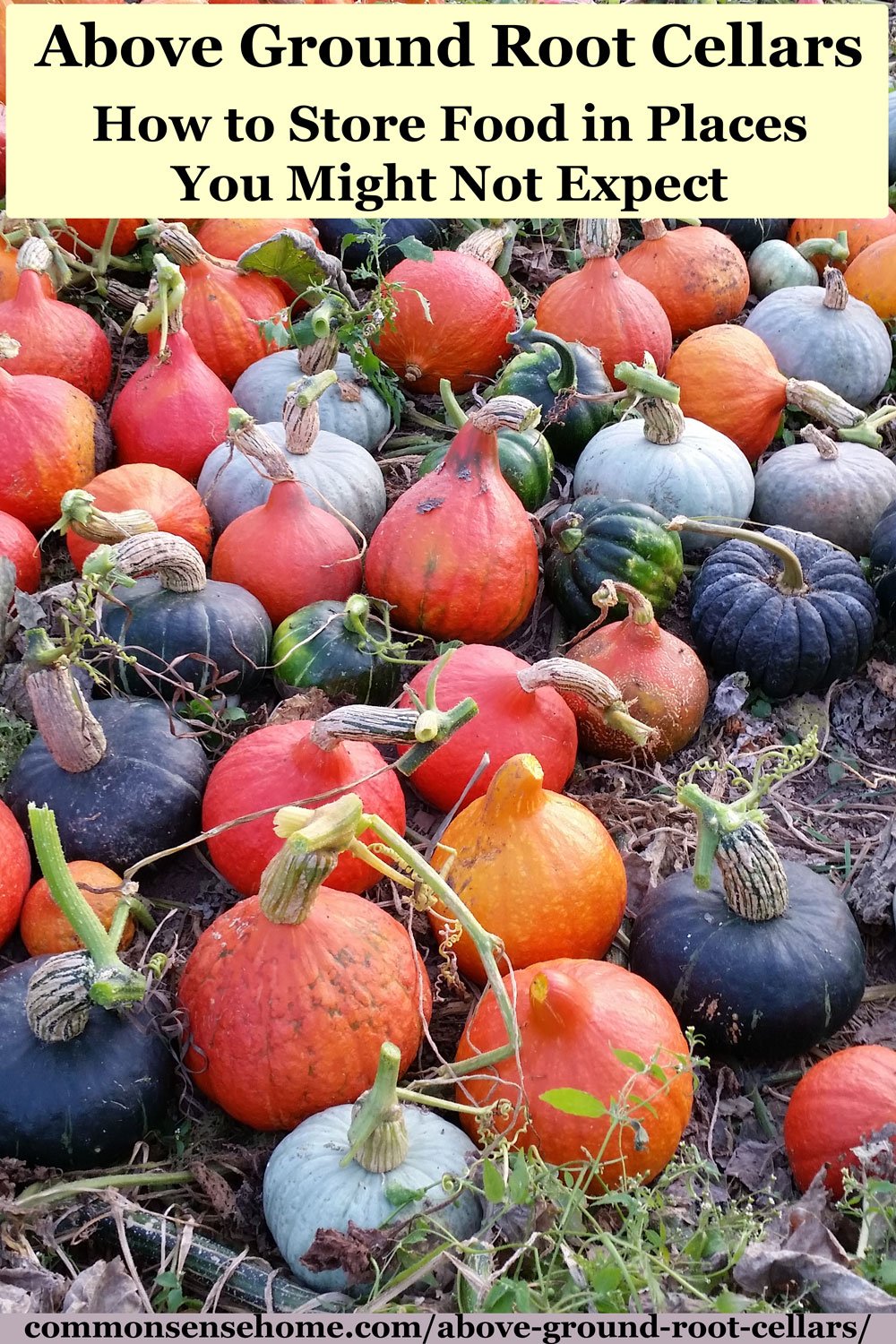
For those in cold climates – there are a number of above ground options that can help you store your harvest without processing.
For those in warm climates – sorry, the physics are not in your favor, unless you have a spring house. The good news is that you can still eat local year round, and we have tips for that, too.
How Root Cellars Work
The goal of a root cellar or other long term food storage area is to create conditions that extend the shelf life of stored food.
In a traditional root cellar in a hole in the ground, it is cool and damp, with no direct sunlight.
The ground surrounding the cellar acts as a constant temperature heat sink. Below roughly three to four feet, the ground maintains a fairly steady temperature (roughly 50-60 F in most areas).
This steady ground temperature helps keep the root cellar cool.
Root cellars need air circulation. Fresh air drops in at night to help lower the temperature in the cellar, and stale air gets vented out. This removes excess ethylene gas generated by certain produce that prematurely ages the produce.
No air flow at all = rotten produce.
This is why burying an old fridge or freezer in the dirt with no ventilation is a bad idea.
Traditional root cellars also have dirt or gravel floors. This helps moderate humidity levels. Most produce prefers fairly high humidity to keep it from withering and wilting. Think of the conditions in the crisper drawer in your fridge.
For a printable guide to storing over 30 different fruits and vegetables, as well as more information on building a root cellar, see the post “Root Cellars 101“.
How much does an above ground root cellar cost?
The cost of an above ground root cellar varies widely. If you build a sandbag root cellar yourself it can be as little as $500 but most will cost $2500 to $25,000+. If you want to earth berm, which we recommend, it will add even more cost especially if you have to bring in fill. Adding earth berm to an above ground root seller provides insulation from heat and cold, and moves the interior temp closer to ground temperature, still warm in Arizona or Texas but in many areas much cooler.
One way to reduce the cost is to consider using the above ground root cellar as both a safe room (storm shelter) and a root cellar. That might get you some funding from FEMA, see more in our related article: Safe Rooms Checklist for New or Retrofit Construction
Consider FEMA Safe Room Funding
Some states will have FEMA reimbursement for new construction or retrofit of a Safe Room or Tornado/Storm Shelter (a below ground or above ground root cellar could potentially be both). Funding info: https://www.fema.gov/emergency-managers/risk-management/safe-rooms/funding
The Hazard Mitigation Grant will reimburse $2000 to $20,000 depending on where you live or 75% of the project whichever is LESS.
Contact your FEMA state rep to get more information. If you are sure you have FEMA coverage in your state, this link will help you fast track reimbursement.
How do we get close to root cellar conditions above ground?
How can we get close to these conditions?
One option is a walk in cooler, like the one my friend, Amber built in South Carolina. You can read how to build your own in the article “Build Your Own Walk In Cooler with a CoolBot Controller and A/C Unit“.
Another alternative is a true above ground root cellar, with earth mounded around a structure that sits above ground. Folks build these out of cinder blocks, old tires, or pour concrete structures.
They don’t have as much earth around them so they don’t insulate as well as a standard root cellar, but they work fairly well. They can also do double duty as a storm shelter. My friend, Colleen, covers building an above ground root cellar in her ebook listed below.

For those who don’t have the time, space, or inclination to build a separate structure, you may be able to repurpose space you already have available.
Above Ground “Root Cellar” Style Options for Cold Climates
Think about areas around your home that stay cooler, but don’t freeze. These are prime targets for your food storage space.
There are also many crops that store well without the moisture of typical root cellar.
Dried shell beans, dried produce and herbs, bulk grains, pumpkins and winter squash, onions and garlic – all of these store well in cool, dry conditions.
Garages and Outbuildings
If you have a garage or outbuilding, you may be able to adapt it for food storage.
You want to buffer your produce from temperature swings. You can do this by storage in coolers or insulated bins if your building is not insulated.
If your building is insulated, adding a second layer of insulation won’t hurt (as long as there is ventilation).
Note that any chemicals in the air (such as gasoline fumes) may be absorbed by fresh produce in open bins. Keep that in mind when you are planning.
We have an insulated garage attached to the house, which I refer to as the “seasonal fridge”. We usually don’t see freezing temps inside the garage until nighttime temperatures dip into the single digits.
If you have an outbuilding with a dirt floor, you can dig into the dirt to make a more accessible in ground storage than burying things out in the yard.
In the book Root Cellaring, they discuss digging in a used metal storage locker. This would protect from rats and mice and provide good ventilation. Buried storage would also be better for root vegetables.
Hanging bags or baskets also help prevent rodent access, but leave the produce more exposed.
Easy Apple Storage
When the local apple picking season is wrapping up, the boys and I hit the orchard.
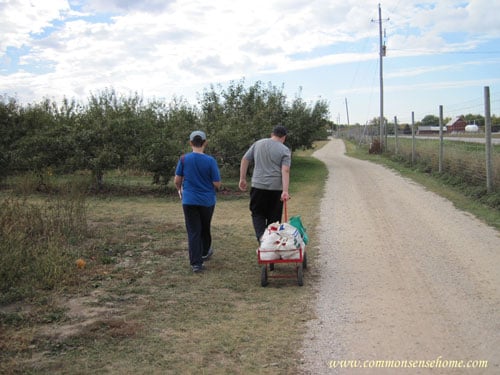
I sort through these apples to remove any that are bruised or blemished, as a single damaged apple really can spoil the whole bin. We pack the apples in old coolers or heavy duty cardboard boxes and place them in the garage.
We store boxes on metal shelves to make them harder for rodents to access and use them first. The coolers are stored at ground level and used later.
We leave the cooler spigot open and leave the lid propped open about 1/4 inch to provide ventilation.
I check the bins regularly to remove any apples with signs of spoilage. The best keepers easily last until January or later.
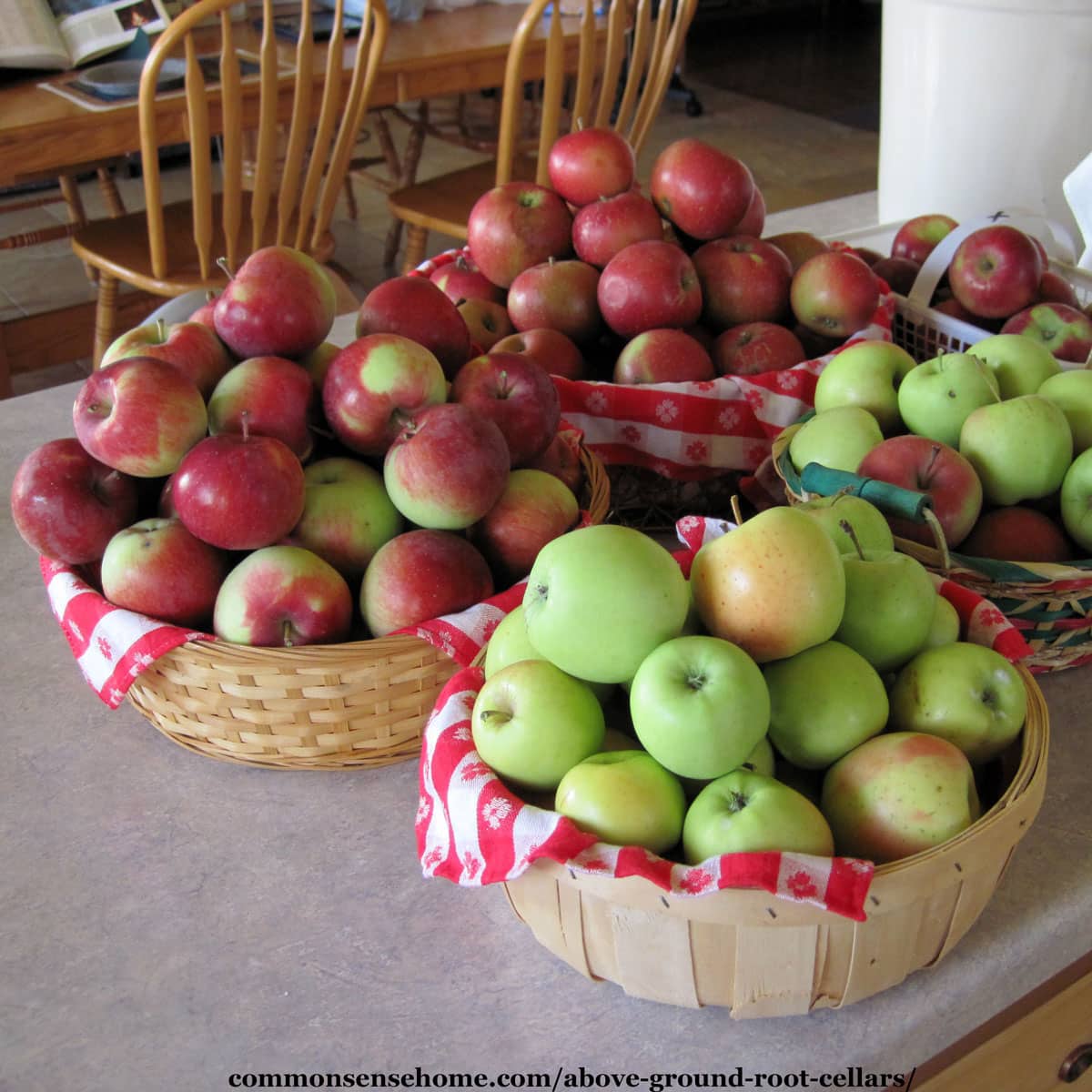
Porches or Decks
If you have an unheated porch or attached deck with high clearance underneath, you may be able to put it to work as an “above ground root cellar”.
Watch out for pests, such as rodents. Heavy duty plastic storage buckets will deter mice and bugs, but rats can gnaw right through plastic and you must protect your storage with metal.
Would you like to save this?
If you combine two layers of protection, say plastic buckets inside a metal garbage can, you can keep food more accessible for you and less accessible for them.
Remember, rodents can cram their bodies through any openings they can get their heads through. If they find their way into your stash, you must take measures to control them and keep them out.
See our post Best ways to get rid of mice in your house and garage for more information.
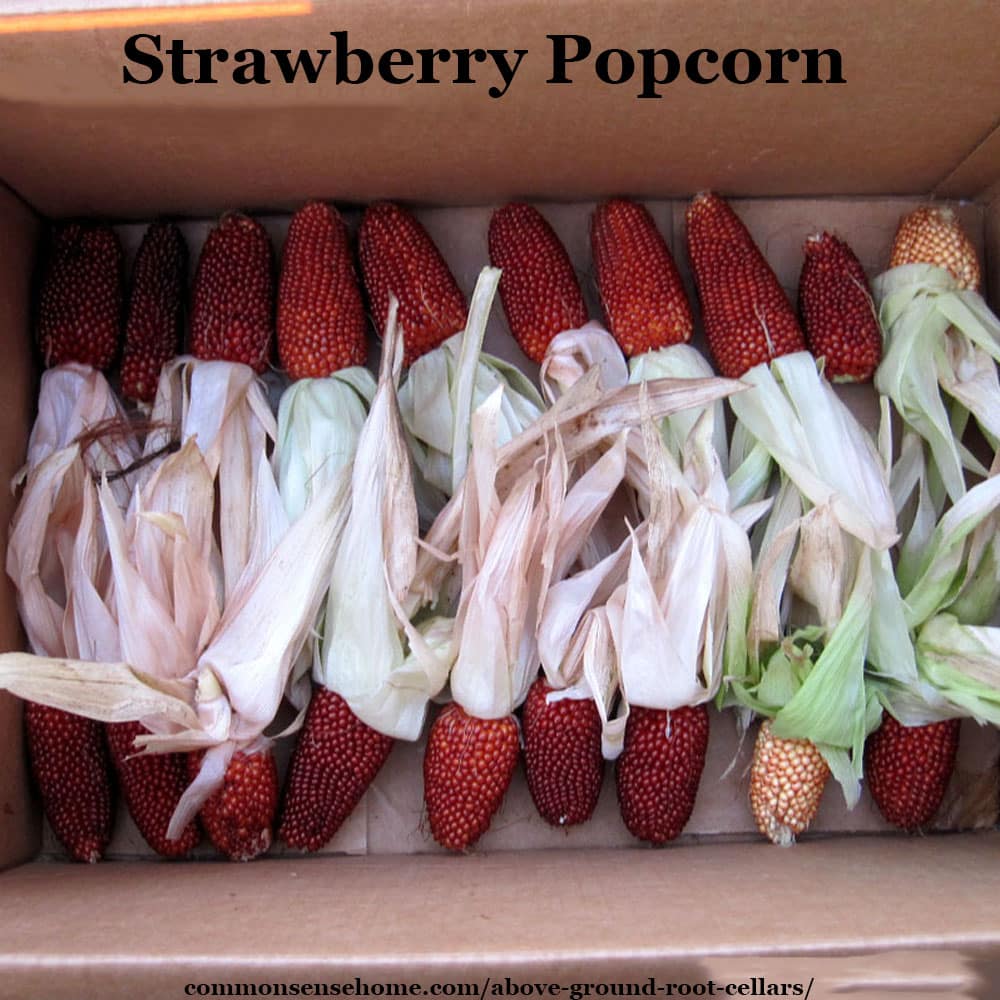
Inside the House
Attics, pantries, bedrooms, stairwells – all of are fair game for food storage. As mentioned earlier, look for areas of the house that are not heated or are minimally heated.
Closets on exterior walls in minimally heated rooms could get very close to actual root cellar conditions. Hiding some squash in a box under the bed may work well for you. Just don’t forget you put them there or the smell of rotting squash will remind you.
Last year I tucked our squash and pumpkin along one side of the stairway from our basement to garage while I waited for other space to become available.
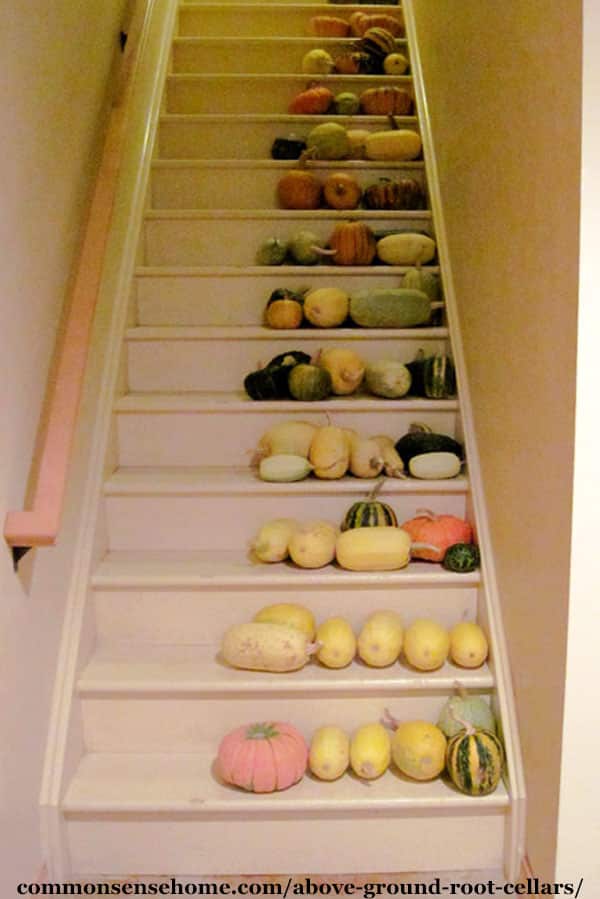
One of our readers shares:
I don’t wash off storage produce until I am ready to cook it. This leaves the protective exudates on and really extend shelf life far beyond store bought squash of all kinds.
Cukes turn yellow and seedy, but taste fine and remain juicy for quite a while. Just brush off leaves and the crumblier soil once squash is cured.
I also pack them in 5 gallon paint strainer bags to keep fruit flies off. I tuck small ones in a napkin and pack them together so the skins don’t touch. Several small ones will fit into one paint bag.
I take large fan covers, line them with a torn open paper sack and set my ventilated “trays” so they get air circulating under them.
I pack squash in one or two shallow layers and set them over some flattened cardboard boxes where they will stay out of direct sunlight, traffic and get good air circulation.
We put a few bricks under the tray for air flow, and the temperature stays around 62F and 67F.
Visit page 2 for warm climate ideas from southwest Louisiana.


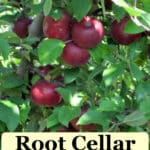
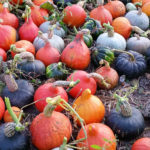
I don’t know why your article is supposed to be about above ground root cellars because it seems you spend most of it trying to talk people out of it. Telling them the physics are against them instead of offering real solutions or finding a cool dark corner of their house like some sorta pack ratting gopher. And creating an unsightly mound in their yard? Really? smh.
How about instead have a conversation involving double walled construction and the advanced in spray foam insulation, and ventilation air circulation systems with humidifiers. And how about the use of geothermal to keep an above ground root cellar cooler. Help people, don’t pretend.
David, what you are proposing is NOT a root cellar, it’s a walk in cooler.
A root cellar relies on natural conduction, transferring the cool ground temperature to the storage area. It is not dependent on powered air circulation, humification, or cooling.
If you are insulating your storage area from the ground, then it is not a root cellar. If you are using electrically powered cooling, it’s a cooler, not a root cellar.
Most people searching for information on root cellars want a low cost, low tech solution. Geothermal cooling systems are not that.
For people who want mechanically cooled above ground storage at a reasonable price, I’d suggest reading the article “Build Your Own Walk In Cooler with a CoolBot Controller and A/C Unit“.
Every one of these pages is a waste of my time. I wish everything involving food storage said, “If you live in Florida and want electricity free food storage, just close this page now. You’re screwed”
Thanks for summing that up, Adam. Yes, if you live in Florida, where it is excessively hot and humid much of the year, food is not going to keep well like it would without electricity in other climates. That’s why I had my friend chime in with her extended growing schedule. I can’t change biology and climate.
I am going to try a broken freezer with a smaller Styrofoam cooler in a garage as a root cellar.
Just make sure to provide adequate ventilation.
Hi! So, we were keeping our root vegetables in paper sacks in our garage, which worked really well. We were hoping to extend the garage storage for our apple harvest this year, but then we found out there are mice in the area, and we switched to a plastic tote. Nope. No good, they sweat and go soft. We do have an inspection-pit in our garage, with wooden boards that form a lid, which I thought would be ideal, but aside from our little hunter-cat(!), how do I make it pest-proof?
Hardware cloth with mesh fine enough the mice can’t get in, but open enough so things can still breath.
Thank you for the great information! I am in NW Oregon, which gets a LOT of rain. I am worried a traditional root cellar would flood, so am looking into “above ground” options. Do you have tips to avoid flooding? I am also curious – would a root cellar double as a cheese affinage environment?
Thanks again!
My friend, Teri, of Homestead Honey built a walk out root cellar (mounded, above ground). She shares her experience in her book “Building a Homestead Root Cellar“. With heavy rains, you’d need to make sure you have excellent drainage (likely including drain tile) around the building, and somewhere it can drain to well away from your storage.
Yes, it’s possible that you may be able to use your root cellar for aging cheese. You’d need to check the specs on your preferred cheese, and see if your cellar meets those needs. Another option is an above ground walk in cooler, which can be built pretty affordably with a Coolbot controller and standard AC unit. You can read more about that here – https://commonsensehome.com/build-walk-in-cooler/
howdy – seeing your squashes on the stairs inspired me: If I put in shelves along a stair wall, what material do you suggest? metal, metal mesh/wire, wood/laminate?
Thanks for the smart info & ideas.
Something washable, or make the surface below washable, because sooner or later you’ll miss one rogue squash that spoils early and end up with a squishy mess. I’d opt for oiled wood over laminate, because wood is naturally antibacterial . (Laminate may retain some of this resistance, but I’ve seen no testing on it.) Pressboard should be avoided entirely, It’s nearly impossible to get spoiled squash out of those nooks and crannies.
If you used wire, I’d opt for 1/4 hardware cloth for long term stability and no sagging. Just make sure that whatever’s beneath the mesh shelf is washable, just in case.
My husband brought home two jumbo zucchinis in Sept. They have sat in the kitchen since I didn’t know what to do with them. Now that I have read your post I have some ideas. But is it too late? Other blogs say throw them away, but it seems like such a waste.
Cut a slice and look at the texture. If it looks good, taste it. If it still tastes good, it should be fine. If it’s squishy or pithy, or “off”, then compost.
Thanks for the advice! I just picked all my carrots this week and decided to try your method of keeping them in coolers in our insulated garage. Do I need to put anything in the coolers with the carrots? Right now I have the layers of unwashed carrots separated with pieces of paper toweling, with the spigot open and the lid cracked slightly. The coolers are up against an inside wall of the garage.
Yes, you need to separate them with leaves (my preferred option), or sawdust or sand. If they’re touching, they tend to spoil faster.
I live in Wales where it the humidity is often around 90%. I’d like to build a sort of above ground root cellar to store garlic in. Given that garlic doesn’t like too much humidity I think I’ll have a bit of a challenge doing this without the use of electricity.
I’m thinking of creating a space with concrete blocks above ground and then covering it with a thick blanket of soil that I’ll take from a track I’m digging nearby. I’ll put a thick wooden door on it with an air vent on the bottom and another air vent that come out of the roof.
We don’t get very harsh winters in Wales. It’s mostly very wet. I’m hoping an above ground building buried in soil maintain a stable temp.
Do you have any suggestions for how I might improve this design to keep the environment drier? I don’t have convinient access to electricity at the site.
The main thing that comes to mind is airflow. If you can put in some cross ventilation to keep the air moving, that should help with the stagnant damp. Garlic is forgiving enough to store quite a while directly in the home, too. I always bring few bulbs up at one time to keep on the kitchen counter for ready use.
I’d put a drain in the floor. The only mistake my grandpa made when he built our cellar was that he put in a drain pipe that was far too small and put it in a place where it did not drain well. The cellar was always damp and the pipe was always clogged at the end.
Good thought, if there’s somewhere it can be drained to away from the building.
Thanks both, that’s useful. Will the drain collect excess moisture in the room, or is it so that you can wash the room out?
I think he’s intending that the drain be in a low point in the room, with a drain pipe exiting the area, so this wouldn’t work if there’s nowhere for it to drain to that’s lower. For instance, we have floor drains in our garage under the vehicles to drain off melted snow in winter.
I lived in an area where all you had to do was dig a few feet down and you’d have water slowly flowing into your hole and we lived at the top of a hill. Our cellar drain was supposed to drain what seeped through the walls. It had a concrete floor. The walls and ceiling were concrete.
It was built about 100 years ago. They did not know how to prevent seepage in that era. Even with the humidity it was still a good cellar.
Hi Laurie,
I live in the UK. I have a garage which I am trying to use as a cold room. The garage is not insulated at all, but I am thinking on bringing my metal shed into the garage, insulate it and use it as a cold room. Will this be alright, do you think?
Temperatures here range from -5C (23F) to 11C (52), except for mid June through mid September when it hits the 28C (83F) mark, sometimes 30C (86F).
I think the shed will not only provide protection against the harsh winter months but will keep it cool during the summer months as well.
Any thoughts?
I am also wondering about ventilation. Should I just make a hole in it and install a small fan?
Any help will be greatly appreciated at this point!
I’ve never seen something quite like this done. It should protect your produce from mice and rats, which is good. Insulation should help level out temperatures, but it may still get too warm in summer. Depending on how everything lines up, you might be able to put a small window air conditioning unit it. There are also systems designed specifically for walk in cold rooms. I have someone working on a post about how they built their cold room.
Ventilation will be needed for sure, preferably to outside. Two holes would be better than one, to pull fresh air in and divert stale air out (one high and one low). You may need to add extra moisture, as a concrete floor will not be as naturally damp as a gravel floor.
I recall my grandparents in Tennessee dug a root cellar under their house just wide enough to stand in, and sprinkled lime on the area surrounding the standing area(the floor of the crawl space). They set potatoes on the lime in a single layer, not touching. I only recall potatoes down there, but there may have been other things. Fruit and veggies were canned. They lived this way for decades. It was very humid there, and only the ventilation of a crawl space and lime to protect the potatoes. There were slugs on the dirt under the house, but not on the lime nor potatoes. I imagine insects don’t like lime. Maybe this is workable in humid places like La. and Fla. Doug
Thanks for sharing this, Robert. Lime inhibits decay (for instance, if you want a body to decompose, don’t sprinkle lime on it), so I’m sure that helped with the preservation. It also has scratchy edges, at least, scratchy enough to deter slugs.
I live in southern Ontario. I’m planning to build a cold storage room in my garage. It has a concrete floor, 2 insulated walls will be exterior, north and west side. It’s about 80 square feet. The ceiling will be spray foamed for insulation and there is a living room above.
I’ve been reading different takes on the ventilation. Should I keep the vents inside the garage – 1 low and 1 high cross-vent or 1 outside high and 1 inside low for cross ventilation?
If I put the vent on the exterior wall could that case the room to get too cold in winter and vice versa in the summer?
Any insight into the set up would be appreciated.
Personally, I’d vent to the exterior. You want to make sure you have good air flow to vent the ethylene gas. Odds are you’re not going to have a cool room year round, but it will moderate the outdoor temperature.
Hi, my name is Paula too and I also live in Louisiana but I live northeast of Baton Rouge. I still have the high humidity problem in the summer and the winter months. Here in Louisiana the humidity is high year round. I also live in a mobile home with 3 bedrooms, my daughter has 1 and I moved my husband and I out of the master into 1 of the other bedrooms, smaller but we don’t mind because I made the master my complete storage room for food and emergency preps. I put those cheap thin storge shelves all along the walls and have buckets in the center with space for me to move in and out and around them. I have central air but don’t use it because it’s too expensive to run 220. So I have window units in every room. But the unit I put in my storgae is always on and ready when the temps rise up and I set it on energy eff. mode so it doesn’t come on until it’s needed.
But here’s my problem with these energy eff. ac’s they on go down to 61 degrees. Even at that temp my apples don’t last , my potatoes want to sprout. I have good circulation as I keep the ceiling fan running year round. So I love my storage room setup but even when it’s cold the humidity is high down here. When the ac is on the room is very dry, winters are my problem. I am a nut case about too much electric use in the house but I feel I am going to invest in a dehumidifier.
Anyone have suggestions for my climate and situation. Paula in SW Louisiana can you give me some advice and any other ideas that you used for our wet environment. Anybody???
I mostly don’t store anything long term. If you’re running window units when the temps get above 61, the main thing an ac does is dry our the humidity and cool things off. That’s probably why your things won’t last.
At least we have 12 month growing unlike Laurie up north. I eat seasonally and locally . Apples don’t grow here but oranges and all the citrus do. Cabbage lasts forever even on a room temp shelf. Sweet potato if cured correctly last a good 6 months in a kitchen pantry. The hard winter squashes should also last 3-4 months . I see pumpkins on people’s porches from last Halloween and they aren’t rotten yet. And you know how wet and hot this winter has been.
Sorry I don’t have any advice in above ground root cellars. It’s just easier for me to grow a winter garden than fight our weather.
Hi Laurie,
I live in Southern California. My wife and I have just bought our first house, we have two small children and have managed to acquire some land (just under an acre).
We have been planting vegetables using the Back to Eden-style and are very excited to have our first crop!
We are growing enough food to last us through the winter and would like to put some by so we can enjoy fresh vegetables and fruit (apples) throughout an extended season.
I looked into the idea of having a root cellar here in Los Angeles, but it doesn’t seem cost-efficient to try to lower the temperature of a “cellar-type” room if were we to have one built.
My other option was to find a large freezer/fridge in the garage to use exclusively as a root cellar. I am wondering the following points.
–would you recommend a freezer (adjusted in aftermarket to keep temps above freezing) or a fridge?
–would air flow (or lack of it) be a problem? I don’t know how often gases are expelled (if at all) in a refrigerator.
–What is the best temperature for keeping stored vegetables/fruit?
–Is there a better solution?
Thanks a lot!
Best,
Jason
Given that you are in Southern California, I may be mistaken, but it’s my understanding that it’s pretty warm there are you’re reasonably likely to be able to grow some type of crops year round, so a strategy like the one my friend in Louisiana uses might work well for you. Adapting to seasonal eating for your area would be the lowest impact option.
If you really want to store some produce, a fridge would be better than trying to adapt a freezer. (No need to reinvent the wheel.) You probably don’t want to put heavy breathers like apples in the same fridge as carrots or potatoes for longer storage. There’s a full chart of option storage conditions/temps in the Root Cellars 101 post.
When using the metal trash cans – how are they ventilated? Should holes be drilled in the lid and near the bottom?
We cover the basics of trash can root cellars in the Root Cellars 101 post.
I am in Oregon, it gets down in the 20’s or below in the winter. I don’t have the space to store all spaghetti squash I have. I have searched online for pressure canning them, but I find equal amounts of pros and cons. What is your suggestion and “how to” on pressure canning spaghetti squash?
I wouldn’t pressure can spaghetti squash. If I didn’t have enough room to root cellar it, I cook it and dehydrate it.
Question about using garage or attic. We have temps that go to -30 during the winter. Have you had your stuff freeze? If I put my stuff in attic in a cooler would that keep it from or lessen the chance of them freezing?
Our garage is fully insulated, which allows us to accommodate a wider range of temperatures without freezing, but when it gets that cold, anything on the garage or porch gets pulled inside somewhere. A cooler will help, but I wouldn’t trust it to protect from freezing in an uninsulated area past single digit temps. Also, make sure the cooler is not sealed tight, or ethylene gas will build up and cause spoilage.
Try living in south Florida…I do well growing 9 months out of the year…and I use row covers to control pests which have done wonders. I roll the covers up during the day for pollination and then about 4:30 or 5 I roll them down for night time. If I see rain in the forecast…I leave my row covers down to avoid fungi or powdery mildew. I use a 70% light exposure on my row covers. I never have to use any pest control or chemicals on my garden. Thus far for the past 4 years…I have been very successful with my garden. I love this method. Now i have bought 14 acres and got certified as a Bee keeper after taking 3 days of intense all day courses. I will use the bee hives to pollinate my fruit trees, veggie garden and for creating wonderful honey. In south florida, we have a long honey making season here being we are considered the Tropics. Now i considering growing only my ROOT veggies above ground in containers. carrots have a hard time in our sandy soils here and the nematodes and megatodes. This controls that. I also grow everything in raised beds w/ drip irrigation. My struggle is trying to have an above ground root cellar. I am considering finding the shadiest area on the property in the summers…and then building an above ground small building covered in soil and dark inside. then placing root veggies in sand cases. Humidity isn’t lack of here in the south. Plenty of it…just learning how to air-rate it with cool air is…
As noted in the article, attempting cold storage using ambient temperature in a hot climate defies the laws of physics (unless you use a mechanical heat pump). Luckily you are blessed with a much longer growing season like my friend, Paula, from Louisiana who wrote the second half of the post.
Thank you for the great tips! I live in a mobile home and right now my kitchen table looks like a farm stand. My freezer and fridge freezer are jam packed and without a pressure canner I am unable to can some of what I have. I was hoping to be able to find a way to store extra apples and I love your idea with the coolers! I happen to have a huge one that would be perfect! I have always used them in winter to extend my freezer / fridge space for holiday baking items and the awesome meat sales until I can cook the huge hams and turkeys down to split into smaller potions and re freeze. The one year we cooked 6 turkeys and about 8 hams! Can not beat the prices though. I just never thought to store produce the same way.
Being in a mobile home I have no attic or basement and space is precious with 4 kids and 2 adults! I already use my linen closet as an extra pantry for my canned goods and I’m considering putting my potatoes and onions under the sink in the kitchen so they are away from the heat of the stove and the light from my windows.
It’s worth a shot. If it doesn’t work well, then you know, and can try something else. Any room under beds? Bedrooms are often cooler, too.
Apples dehydrate wonderfully and take up much less space. I put mine in old peanut butter jars. Easy to carry with you .
Thank you so much, you give me hope! We’re in Houston. We’ve had success with a few things, but so much really does seem a waste of effort, time, etc.. You’ve helped renew my optimism. 🙂
Every climate has it’s challenges, but folks managed to get by in the past so I figure if we get creative we can do more for ourselves locally, too. Good luck! If you have time and think of it, do stop back and let me know how things go.
do you have any advice for the people up in Canada where we get winter temp as low as -40?
Using a traditional root cellar inside the cellar of the house would probably work best. That’s what we used up in northwest Wisconsin, where we would sometimes see similar temps. There’s more information on traditional root cellars here – https://commonsensehome.com/root-cellars-101/
When I was a kid growing up on a farm in Southeast Missouri we had a cellar. There were winters where the temps were below 0 degrees Farenheit or -32 Celcius. We never lost anything in our cellar to freezing but I’ve often wondered what would have happened if we’d had a month of weather like that.
Food storage was actually a secondary purpose for our cellar. It’s main use was as a storm shelter.
We have had a month like that, and ours was cool, but no freezing. It worked well.
Come to think of it I remember that part of the concrete near the vent was exposed for a few years. This was caused by several generations of kids playing on top of the cellar and causing the dirt to erode. We did not lose anything to freezing. Dad eventually got the cellar covered with dirt again.
The concrete walls and ceiling were pretty thick. My Grandpa built the cellar after watching a neighbors farm get torn up by a tornado. There were iron rails from a bankrupt railroad imbedded in the concrete.
Ah, now that makes sense. Without the dirt insulation, the cold would transfer much easier.
Thank you for this post. We have tons of cucumbers we need to tuck away also, any tips? I do not want to make pickles out of all of them
Cukes, alas, are best enjoyed fresh. Their high water content and low acidity makes them shrivel and spoil without some adjustment in pH and moisture levels – thus, the pickle. They do not dry well. They do not freeze well. You might try freezing a batch of sliced refrigerator pickles to give you a taste/texture that was closest to fresh. There is the option of relish, but one can only eat so much of that, too. Would there by the possibility of swapping with a neighbor for something that stores better? Otherwise food pantries almost always appreciate fresh produce.
It is always nice to make freezer cukes and onions and they stay crispy.
Oh my goodness! A SW Louisiana gardener! I’m down here too and it seems SO hopeless, between bugs, heat, and humidity. That was so encouraging! Thank you!
~april
I told Paula she’s welcome to share her tips for fending off the bugs if she’d like to write some more. I’ll let her know you found the post helpful.
I am a transplant to S LOUISIANA and have had nothing but trouble trying to grow anything. Heat, humidity, pests etc…very disappointing after decades of always having a very productive vegetable garden and flower gardens. Glad to see your post, gives me hope to keep trying.
Hot and humid gardening has to be tackled differently than temperate climate gardening, but the right plants can still produce a good harvest.